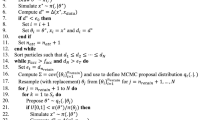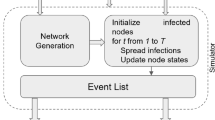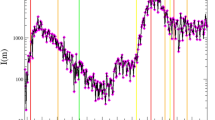Abstract
Forecasting disease spread is a critical tool to help public health officials design and plan public health interventions. However, the expected future state of an epidemic is not necessarily well defined as disease spread is inherently stochastic, contact patterns within a population are heterogeneous, and behaviors change. In this work, we use time-dependent probability generating functions (PGFs) to capture these characteristics by modeling a stochastic branching process of the spread of a disease over a network of contacts in which public health interventions are introduced over time. To achieve this, we define a general transmissibility equation to account for varying transmission rates (e.g. masking), recovery rates (e.g. treatment), contact patterns (e.g. social distancing) and percentage of the population immunized (e.g. vaccination). The resulting framework allows for a temporal and probabilistic analysis of an intervention’s impact on disease spread, which match continuous-time stochastic simulations that are much more computationally expensive. To aid policy making, we then define several metrics over which temporal and probabilistic intervention forecasts can be compared: Looking at the expected number of cases and the worst-case scenario over time, as well as the probability of reaching a critical level of cases and of not seeing any improvement following an intervention. Given that epidemics do not always follow their average expected trajectories and that the underlying dynamics can change over time, our work paves the way for more detailed short-term forecasts of disease spread and more informed comparison of intervention strategies.





Similar content being viewed by others
References
Aleta A, Hu Q, Ye J, Ji P, Moreno Y (2020) A data-driven assessment of early travel restrictions related to the spreading of the novel COVID-19 within mainland China. Chaos, Solitons Fractals 139:110068. https://doi.org/10.1016/j.chaos.2020.110068
Allen A (2023) andrea-allen/pgf-networks. GitHub. Retrieved from https://github.com/andrea-allen/pgf-networks
Allen A (2021) andrea-allen/epintervene. Retrieved from https://doi.org/10.5281/zenodo.5076514
Allen AJ, Boudreau MC, Roberts NJ, Allard A, Hébert-Dufresne L (2022) Predicting the diversity of early epidemic spread on networks. Phys Rev Res 4:013123. https://doi.org/10.1103/PhysRevResearch.4.013123
Althouse BM, Wallace B, Case B, Scarpino SV, Allard A, Berdahl AM, Hébert-Dufresne L (2020) The unintended consequences of inconsistent pandemic control policies (Preprint No. medRxiv:2020.08.21.20179473)
Ames GM, George DB, Hampson CP, Kanarek AR, McBee CD, Lockwood DR, Achter JD, Webb CT (2011) Using network properties to predict disease dynamics on human contact networks. Proc R Soc B Biol Sci 278(1724):3544–3550. https://doi.org/10.1098/rspb.2011.0290
Bansal S, Grenfell BT, Meyers LA (2007) When individual behaviour matters: homogeneous and network models in epidemiology. J R Soc Interface 4(16):879–891. https://doi.org/10.1098/rsif.2007.1100
Block P, Hoffman M, Raabe IJ, Dowd JB, Rahal C, Kashyap R, Mills MC (2020) Social network-based distancing strategies to flatten the COVID-19 curve in a post-lockdown world. Nat Hum Behav 4:588–596. https://doi.org/10.1038/s41562-020-0898-6
Chu DK, Akl EA, Duda S, Solo K, Yaacoub S, Schünemann HJ, Schünemann HJ (2020) Physical distancing, face masks, and eye protection to prevent person-to-person transmission of SARS-CoV-2 and COVID-19: a systematic review and meta-analysis. Lancet 395:1973–1987. https://doi.org/10.1016/S0140-6736(20)31142-9
Churches T, Jorm L (2020) Flexible, freely available stochastic individual contact model for exploring COVID-19 intervention and control strategies: development and simulation. JMIR Public Health Surveill 6:e18965. https://doi.org/10.2196/18965
Davies NG, Kucharski AJ, Eggo RM, Gimma A, Edmunds WJ, Jombart T, Liu Y (2020) Effects of non-pharmaceutical interventions on COVID-19 cases, deaths, and demand for hospital services in the UK: a modelling study. Lancet Public Health 5:e375–e385. https://doi.org/10.1016/S2468-2667(20)30133-X
Hébert-Dufresne L, Althouse BM (2015) Complex dynamics of synergistic coinfections on realistically clustered networks. Proc Natl Acad Sci USA 112:10551–10556. https://doi.org/10.1073/pnas.1507820112
Hébert-Dufresne L, Patterson-Lomba O, Goerg GM, Althouse BM (2013) Pathogen mutation modeled by competition between site and bond percolation. Phys Rev Lett 110:108103. https://doi.org/10.1103/PhysRevLett.110.108103
Hébert-Dufresne L, Young JG, Bedson J, Skrip LA, Pedi D, Jalloh MF, Raulier B, Lapointe-Gagnéo, Jambai A, Allard A, Althouse BM (2021) The network epidemiology of an Ebola epidemic. arXiv preprint arXiv:2111.08686
Kenah E, Robins JM (2007) Second look at the spread of epidemics on networks. Phys Rev E 76(3):036113. https://doi.org/10.1103/PhysRevE.76.036113
Kojaku S, Hébert-Dufresne L, Mones E, Lehmann S, Ahn Y-Y (2021) The effectiveness of backward contact tracing in networks. Nat Phys 17:652–658. https://doi.org/10.1038/s41567-021-01187-2
Lempert RJ, Popper SW, Bankes SC (2010) Robust Decision Making: Coping with Uncertainty. Futurist, 44 , 47–48, Retrieved from https://www.proquest.com/openview/624dcdc33173abd5dff56acf88baf624/1
Milne GJ, Kelso JK, Kelly HA, Huband ST, McVernon J (2008) A small community model for the transmission of infectious diseases: comparison of school closure as an intervention in individual-based models of an influenza pandemic. PLoS ONE 3:e4005. https://doi.org/10.1371/journal.pone.0004005
Newman MEJ (2002) Spread of epidemic disease on networks. Phys Rev E 66:016128. https://doi.org/10.1103/PhysRevE.66.016128
Noël P-A, Davoudi B, Brunham RC, Dubé LJ, Pourbohloul B (2009) Time evolution of epidemic disease on finite and infinite networks. Phys Rev E 79:026101. https://doi.org/10.1103/PhysRevE.79.026101
Pastor-Satorras R, Vespignani A (2002) Immunization of complex networks. Phys Rev E 65:036104. https://doi.org/10.1103/PhysRevE.65.036104
Peak CM, Childs LM, Grad YH, Buckee CO (2017) Comparing nonpharmaceutical interventions for containing emerging epidemics. Proc Natl Acad Sci USA 114:4023–4028. https://doi.org/10.1073/pnas.1616438114
Rosenblatt SF, Smith JA, Gauthier GR, Hébert-Dufresne L (2020) Immunization strategies in networks with missing data. PLoS Comput Biol 16:e1007897. https://doi.org/10.1371/journal.pcbi.1007897
Sun C, Zhai Z (2020) The efficacy of social distance and ventilation effectiveness in preventing COVID-19 transmission. Sustain Cities Soc 62:102390. https://doi.org/10.1016/j.scs.2020.102390
Wessel L, Hua Y, Wu J, Moghadas SM (2011) Public health interventions for epidemics: implications for multiple infection waves. BMC Public Health 11:S2. https://doi.org/10.1186/1471-2458-11-S1-S2
White ER, Hébert-Dufresne L (2020) State-level variation of initial COVID-19 dynamics in the United States. PLoS ONE 15:e0240648. https://doi.org/10.1371/journal.pone.0240648
Wilf HS (2005) Generatingfunctionology (3rd ed.). Natick, Massachusetts 01760: A K Peters/CRC Press. Retrieved from https://www.routledge.com/generatingfunctionology-Third-Edition/Wilf/p/book/9781568812793
Acknowledgements
M.C.B. is supported as a Fellow of the National Science Foundation under NRT award DGE-1735316. A.J.A. and L.H.-D. acknowledge financial support from the National Institutes of Health 1P20 GM125498-01 Centers of Biomedical Research Excellence Award and N.J.R. is supported by the University of Vermont. A.A. acknowledges financial support from the Sentinelle Nord initiative of the Canada First Research Excellence Fund and from the Natural Sciences and Engineering Research Council of Canada (project 2019-05183).
Author information
Authors and Affiliations
Corresponding author
Additional information
Publisher's Note
Springer Nature remains neutral with regard to jurisdictional claims in published maps and institutional affiliations.
Rights and permissions
Springer Nature or its licensor (e.g. a society or other partner) holds exclusive rights to this article under a publishing agreement with the author(s) or other rightsholder(s); author self-archiving of the accepted manuscript version of this article is solely governed by the terms of such publishing agreement and applicable law.
About this article
Cite this article
Boudreau, M.C., Allen, A.J., Roberts, N.J. et al. Temporal and Probabilistic Comparisons of Epidemic Interventions. Bull Math Biol 85, 118 (2023). https://doi.org/10.1007/s11538-023-01220-w
Received:
Accepted:
Published:
DOI: https://doi.org/10.1007/s11538-023-01220-w




